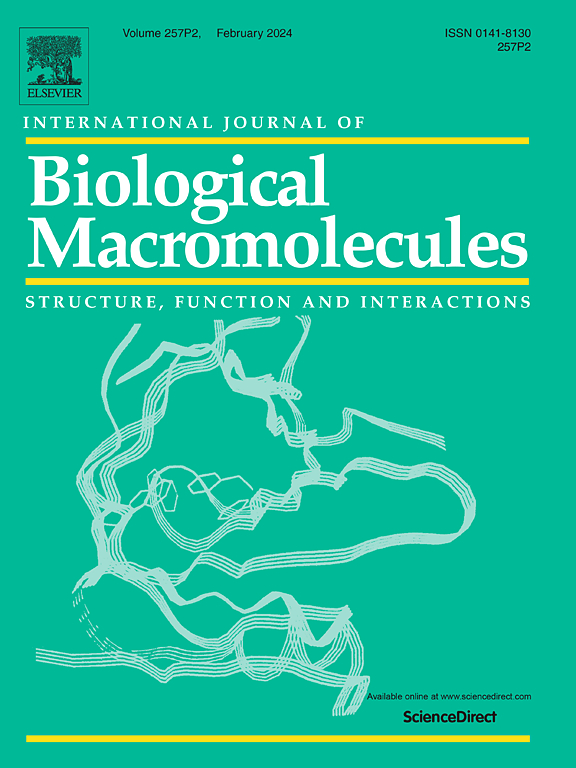Fucoidan from Stichopus chloronotus relieved DSS induced ulcerative colitis through inhibiting intestinal barrier disruption and oxidative stress
IF 8.5
1区 化学
Q1 BIOCHEMISTRY & MOLECULAR BIOLOGY
International Journal of Biological Macromolecules
Pub Date : 2024-12-01
DOI:10.1016/j.ijbiomac.2024.137811
引用次数: 0
Abstract
Intestinal barrier disruption and oxidative stress are the major pathological features during the ulcerative colitis (UC). The present research aimed to explore the amelioration property of fucoidan of Stichopus chloronotus (Fuc![]() Sc) against dextran sulfate sodium (DSS) resulted UC. The findings from our study suggest that treating with Fuc-Sc improved the integrity of the Caco-2 monolayer through raising its TEER value, reducing LDH release, promoting the tight junction proteins (TJs) in Caco-2 cells, and shielding the cells from decreases of these proteins caused by H2O2. Besides, Fuc-Sc activated Nrf2/HO-1 pathway to facilitate the antioxidant activities of Caco-2 cells under oxidative stress through elevating the SOD and GSH, and reducing LDH and MDA. Furthermore, oral administration of Fuc-Sc attenuated DSS resulted body weights decrease, DAI score increase, colon length decrease, and structural damage of colon tissue. Fuc-Sc also promoted the barrier function and suppressed oxidative injury via activation of Nrf2/HO-1 signal pathway. Collectively, this research provided the theoretical foundation for fucoidan as a promising functional food for colitis.
Sc) against dextran sulfate sodium (DSS) resulted UC. The findings from our study suggest that treating with Fuc-Sc improved the integrity of the Caco-2 monolayer through raising its TEER value, reducing LDH release, promoting the tight junction proteins (TJs) in Caco-2 cells, and shielding the cells from decreases of these proteins caused by H2O2. Besides, Fuc-Sc activated Nrf2/HO-1 pathway to facilitate the antioxidant activities of Caco-2 cells under oxidative stress through elevating the SOD and GSH, and reducing LDH and MDA. Furthermore, oral administration of Fuc-Sc attenuated DSS resulted body weights decrease, DAI score increase, colon length decrease, and structural damage of colon tissue. Fuc-Sc also promoted the barrier function and suppressed oxidative injury via activation of Nrf2/HO-1 signal pathway. Collectively, this research provided the theoretical foundation for fucoidan as a promising functional food for colitis.
褐藻糖胶通过抑制肠屏障破坏和氧化应激缓解了DSS诱导的溃疡性结肠炎。
肠屏障破坏和氧化应激是溃疡性结肠炎(UC)的主要病理特征。本研究旨在探讨褐藻糖胶(FucSc)对葡聚糖硫酸钠(DSS)导致的溃疡性结肠炎的改善作用。研究结果表明,Fuc-Sc能提高Caco-2单层的TEER值,减少LDH的释放,促进Caco-2细胞中的紧密连接蛋白(TJs),并保护细胞免受H2O2导致的这些蛋白减少的影响,从而改善Caco-2单层的完整性。此外,Fuc-Sc 还能激活 Nrf2/HO-1 通路,通过提高 SOD 和 GSH 以及降低 LDH 和 MDA 来促进 Caco-2 细胞在氧化应激下的抗氧化活性。此外,口服 Fuc-Sc 可减轻 DSS 导致的体重下降、DAI 评分升高、结肠长度缩短和结肠组织结构损伤。Fuc-Sc还能通过激活Nrf2/HO-1信号通路促进屏障功能,抑制氧化损伤。总之,这项研究为褐藻糖胶作为一种治疗结肠炎的功能性食品提供了理论基础。
本文章由计算机程序翻译,如有差异,请以英文原文为准。
求助全文
约1分钟内获得全文
求助全文
来源期刊
CiteScore
13.70
自引率
9.80%
发文量
2728
审稿时长
64 days
期刊介绍:
The International Journal of Biological Macromolecules is a well-established international journal dedicated to research on the chemical and biological aspects of natural macromolecules. Focusing on proteins, macromolecular carbohydrates, glycoproteins, proteoglycans, lignins, biological poly-acids, and nucleic acids, the journal presents the latest findings in molecular structure, properties, biological activities, interactions, modifications, and functional properties. Papers must offer new and novel insights, encompassing related model systems, structural conformational studies, theoretical developments, and analytical techniques. Each paper is required to primarily focus on at least one named biological macromolecule, reflected in the title, abstract, and text.
文献相关原料
公司名称
产品信息
阿拉丁
Dextran sulphate sodium

 求助内容:
求助内容: 应助结果提醒方式:
应助结果提醒方式:


